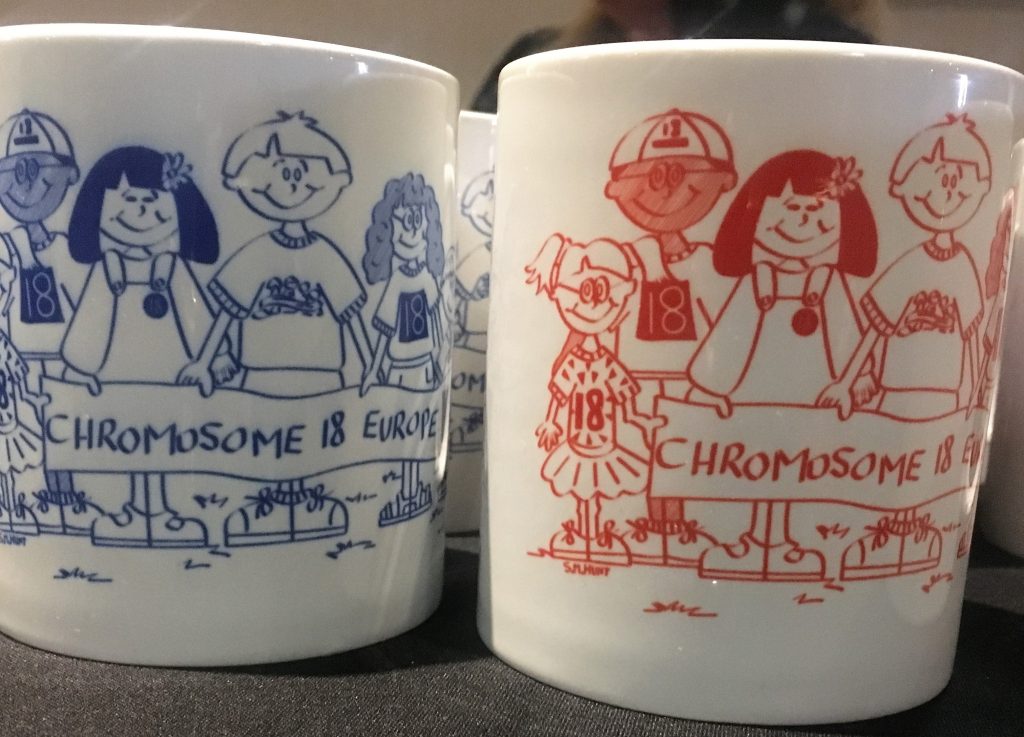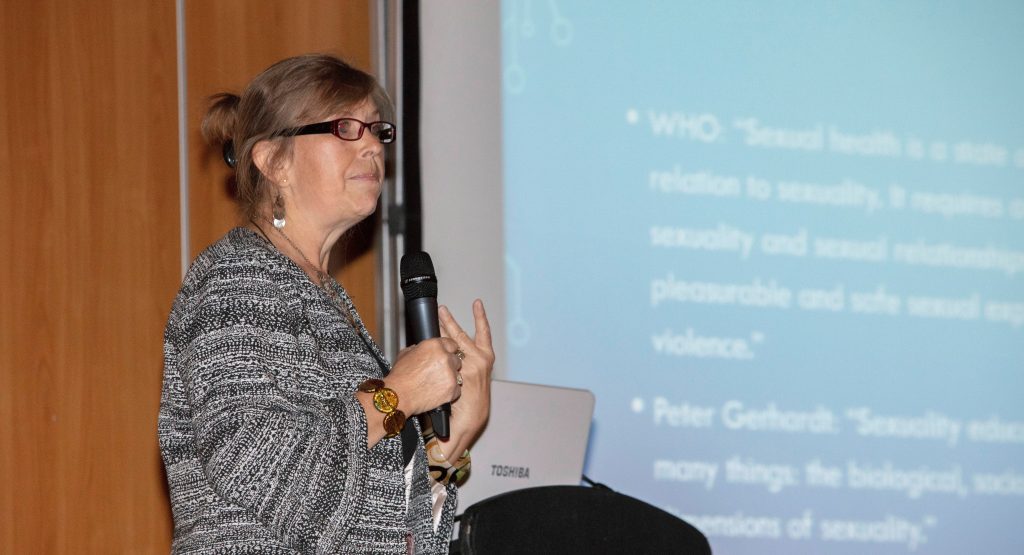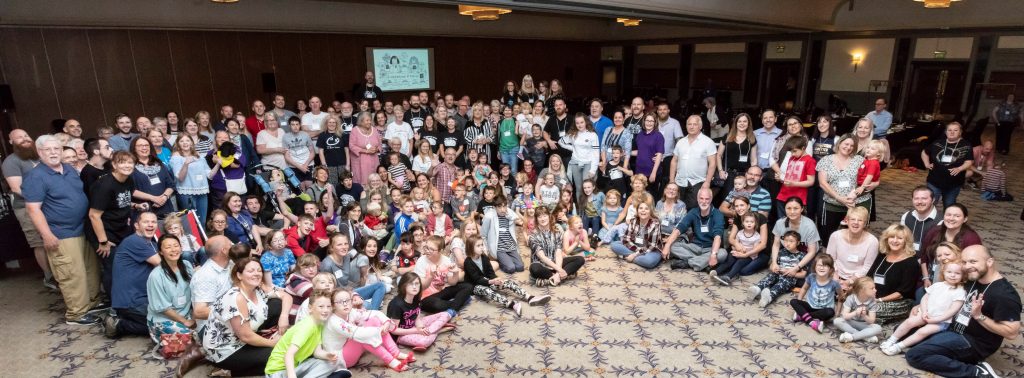JKP author, researcher and speaker Kate E. Reynolds recently travelled to the Chromosome 18 Europe conference, to speak to attendees about sexuality and relationships. Here, she tells us about her visit, and the work done by Chromosome 18 Europe.
Glasgow
Doubletree Hilton Hotel is in the centre of Glasgow. It’s taken me over eight hours to get here, driving bumper-to-bumper for much of the journey and wondering whether I’d have been better off running the gauntlet of north western train services instead. The other alternative was flying from Bristol, that being the shortest travel time. Disadvantage? The available flights couldn’t accommodate my son’s respite care at a farm several miles south of our home.
I am greeted with a room card and, curiously, a warmed cookie. I decide to familiarise myself with the conference room in preparation for speaking tomorrow. Many rows of chairs behind long tables face a large screen and a small stage. The room is airy. For airy, read ‘your voice becomes thin and disappears.’ The staff member who has helped me tells me to take my time to practise. I have a feeling he thinks I’m going to rehearse the entire presentation. Instead I plug in my computer and listen to my voice, a feature which I describe as being nasal and dull. I’m not convinced I can make it sound more interesting. I’ll check for glazed expressions when I speak.
I’ve been asked here to give a presentation about relationship and sexuality education. There’s nothing unusual in that. However, before this conference I had no knowledge of the rare range of conditions surrounding Chromosome 18 deletions and alterations.

A little bit about Chromosome 18
Typically, humans have 46 chromosomes in each human cell, divided into 23 pairs. Each pair is made up of 2 copies of each chromosome, 1 copy from each parent. Chromosome 18 contains anything from 200 to 300 genes which tell the body how to make proteins which perform different and vital roles in the human body.
In similarity to autism, Chromosome 18 causes a spectrum of conditions depending the extent of changes in the structure or number of copies of chromosome 18. As is also emphasised in ASD, each person affected is an individual with no two people presenting with exactly the same symptoms as another. Some individuals have particular facial or physical features, other may have cognitive delays and intellectual disabilities to greater or lesser degrees.
Some of the parents who attend the conference speak of being part of the ‘Trisomy’ or ‘ring’ groups into which they are divided for some group work. This refers to the specific nature of the alteration to the chromosome 18.
The conference includes Syndrome Coordinators who work with these different groups, namely:
Tetrasomy 18p
18q –
Trisomy 18
Ring 18
18p –
The Glasgow conference is conducted as part of the Chromosome 18 Europe arm of the global organisation. In addition, there is a Chromosome 18 Australasia and the largest component, the Chromosome 18 Registry and Research Society based in Texas in the United States (US). Their mission statement is to enable those affected by Chromosome 18 conditions to overcome structural, medical and other barriers to aspiring to and achieving productive and fulfilling lives. As well as a focus on education and research one of their notable aims is to foster a supportive community surrounding those with Chromosome 18. The Glasgow conference certainly feels like a significant component of this last goal, by providing a space for families to share experiences and support each other.

Speaking at the conference
The striking aspect of the conference is that whole families have attended. Breakfast in the hotel is a far more lively affair than I’m used to at similar events. Children and young people, some with clear cognitive challenges, are with their families. A well-staffed creche provides care for many of the children and their siblings, although one or two prefer to come into the conference hall. One boy actually joins an accommodating and versatile speaker on stage.
My slot is first, at 9 o’clock. It’s a difficult time slot with numerous people arriving over the first 15 minutes as they finish breakfast and access the creche facilities. I work through the presentation, giving as many tangible examples as I can without breaching confidentiality. I speak about:
- When to start discussing the different elements of relationships and sexuality
- What to include when broaching the subject
- How to initiate the subject, using opportunistic or ‘teachable’ moments
These areas tend to be problematic for parents, causing delays in discussions until there are obvious indications that the young person is sexually maturing, generally by behaving sexually in public spaces. One of the difficulties with waiting to address what might be termed the ‘basics’ of sex education is that sexual behaviours in inappropriate places may become established and more difficult to address.
At the conference I expect numerous questions about individual situations, so have arranged to stay all day to cover this eventuality. In the event, I find myself asked to run two follow-up workshops, one about girls/young women and one focusing on boys/young men.
Workshops
The first workshop about girls and young women is overwhelmed with mothers and one father. Questions largely concentrate on any potential differences that Chromosome 18 might make to puberty, such as a delay, and menstruation/periods. The beauty of group work is that carers can bounce thoughts and challenges off each other. Parents’ experiences are vast and reflect differences between counties and even the countries which make up the UK.
The second session focuses on puberty among boys and young men, one of whom attends. As is common in such workshops, the emphasis is on masturbation and how to manage it in public arenas. The discussion is mainly on prevention of masturbation by thinking of techniques to teach the young person that their bedroom is the one private place they can practise masturbation and what to do if they begin to masturbate publicly. One of the notable points is that attending parents seem accepting of masturbation per se, which can sometimes be an issue.

The Chromosome 18 Family
Figures for those affected by Chromosome18 are not clear and may be under-reported. 220 families joined the registry in 2017 alone and this is likely to increase with better diagnosis and knowledge of related conditions. At the end of the day of the conference everyone poses for a (very large) group photo. It is at this point that I realise that most people know the names of all the children and self-advocates at the conference. This cements the feeling of family and being supportive to one another.
- To find out more about Kate Reynolds’ work, click HERE.
- For more information about Chromosome 18, click HERE.
If you would like to read more articles like this and get the latest news and offers on our books about autism, why not join our mailing list? We can send information by email or post as you prefer. You may also be interested in liking our Autism, Asperger’s and related conditions Facebook page.